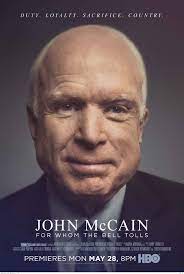
JOHN McCAIN: FOR WHOM THE BELL TOLLS
US, 2018, 104 minutes, Colour.
Directed by George Kunhardt, Peter W Kunhardt, Teddy Kunhardt.
John McCain is a well-remembered American.
Born into a naval family, trained in Annapolis, combat fighter in Vietnam, prisoner of war for five years, campaigner about those missing in action, American senator, presidential candidate, John McCain had a significant American life.
This documentary was released in 2018, the year of his death. He appears in the film, talking to camera in the final years of his life, conscious of his cancer, emphasising his zest for life and work.
The title of the film comes from McCain’s favourite novel, For Whom the Bell Tolls by Ernest Hemingway (and a glimpse of Gary Cooper from the film). He refers to it throughout the film, even at the end of his life. The central character, Robert Jordan, prepared to lay down his life for a worthy cause.
McCain is fortunate to have the Kunhards as his cinema biographers. From 2014 to 2021, Peter W Kunhardt made a series of exemplary documentaries, including An In his Own Words, a documentary about the Kundhardts and their research on Lincoln, a film about Warren Buffett, a film about Martin Luther King and his difficulties, and, in 2021, three part series on Barack Obama.
While there is admiration for McCain, this portrait includes many warts, many of them drawn attention to buy McCain himself. There is his failed marriage after his release from Vietnam imprisonment, a short temper, sometimes blunt expression of what he believed was the truth, some misjudgments in being too political rather than honest, and some choices, especially that of Sarah Palin as his vice presidential running candidate in 2018.
There is quite a deal of photographic material, video material, newsreel footage, social media to draw on. Which means that the audience has a clear portrait of McCain as a boy, young man, training, pilot, photographs from his time as a prisoner of war, with his family, with his second wife and family, in campaigns, associate of presidents, his work as a senator, the two presidential campaigns and the different styles. While there are quotations from George W Bush, his rival in 2000, photographs with Reagan, the main testimonies about him are from Bill Clinton, Barack Obama, his rival in 2008, and, especially, a long friendship and association with Joe Biden.
Audiences will find it interesting to learn about his being taken as a prisoner of war, isolation, some torture, his physical injuries, going to hospital because they learnt that his father was high in the American Navy, but his isolation for many years, testimony from someone who shared a cell with him. There are the negotiations for the release of the prisoners of war, the return, and comparisons with presidential candidate, John Kerry, who took antiwar stances on his return, was admired by McCain though with different perspectives but, ultimately, working together to solve the mystery of MIAs.
McCain is something of a workaholic, wanting to be on the move, a list of his achievements in the Senate presented at the end of the film. Of interest is the campaign in 2000, a friendly campaign, travelling around in his bus, open to the media, and falling foul of public opinion on the flying of the Confederate flag in South Carolina. By contrast, he was far more wary of the media who thousand and eight who, by that stage were asking questions and interpreting the answers in a condemnatory way. He was interested in former Democrat Senator Joe Lieberman standing as his vice president which was not a popular move – and then, the choice and presentation of Sarah Palin.
As mentioned, in this context, there are comments of admiration by both Obama and Biden.
An example of life will-lived, admired by those who did not agree with many of McCain stances and actions.